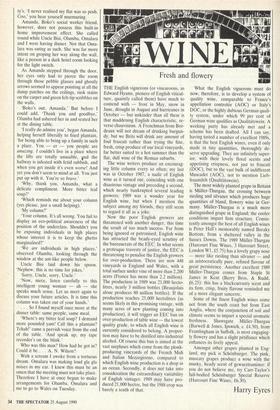Fresh and flowery
THE English vignerons (or vinearoons, as Edward Hyams, pioneer of English viticul- ture, quaintly called them) have much to contend with — frost in May, snow in June, drought in August and hurricanes in October — but unkinder than all these is that maddening English characteristic, re- verse chauvinism. A Frenchman from Bor- deaux will not dream of drinking burgun- dy, but we Brits will drink any amount of foul frascati rather than trying the fine, fresh, crisp produce of our local vineyards, far better suited to a hot summer than the flat, dull wine of the Roman suburbs.
The wine writers produce an encourag- ing little column every so often; my last was in October 1987, a nadir of English wine as it turned out, coinciding with one disastrous vintage and preceding a second, which nearly bankrupted several leading growers; 1989 was a wonder year for English wine, but when I mention the • subject among my friends, they still seem to regard it all as a joke.
Now the poor English growers are threatened with another danger, this time the result of too much success. Far from being ignored or patronised, English wine has attracted the beady-eyed scrutiny of the bureaucrats of the EEC. In what seems a grotesque travesty of justice, the EEC is threatening to penalise the English growers for over-production. There are now 448 vineyards in England and Wales, with a total surface under vine of more than 2,200 acres (France has more than 2.2 million). The production in 1989 was 21,000 hecto- litres, nearly 3 million bottles (Beaujolais alone produces 80 million bottles). If the production reaches 25,000 hectolitres (as seems likely in this promising vintage, with many acres of new planting coming into production), it will trigger an EEC ban on over-production of table wine — the lowest quality grade, to which all English wine is currently considered to belong. A propor- tion may have to be distilled into industrial alcohol. Of course this ban is aimed at the vast surpluses which come from the plonk- producing vineyards of the French Midi and Italian Mezzogiorno, compared to which English wine production is a drop in an ocean. Secondly, it does not take into consideration the extraordinary variability of English vintages: 1989 may have pro- duced 21,000 hectos, but the 1988 crop was barely a tenth of that. What the English vignerons must do now, therefore, is to develop a system of quality wine, comparable to France's appellation controlee (AOC) or Italy's DOC, or the highly dubious German quali- ty system, under which 99 per cent of German wine qualifies as Qualitatswein. A working party has already met and a scheme has been drafted. All I can say, having tasted a number of excellent 1989s, is that the best English wines, even if only made in tiny quantities, thoroughly de- serve upgrading. They are infinitely super- ior, with their lovely floral scents and appetising crispness, not just to frascati (DOC), but to the vast bulk of indifferent Muscadet (AOC), not to mention Lieb- fraumilch (Qualitatswein).
The most widely planted grape in Britain is Mailer-Thurgau, the crossing between riesling and silvaner which produces huge quantities of bland, flowery wine in Ger- many. Muller-Thurgau is a much more distinguished grape in England; the cooler conditions impart firm structure. Consis- tently amongst the best of all English wines is Peter Hall's memorably named Breaky Bottom, from a sheltered valley in the Sussex Downs. The 1989 Mfiller-Thurgau (Harcourt Fine Wines, 3 Harcourt Street, London Wl, £5.75) has a lovely grapy nose — more like riesling than silvaner — and an aristocratically pure, refined flavour of great persistence. Another excellent 1989 Muller-Thurgau comes from Staple St James in Kent (Berry Bros, & Rudd, £6.25): this has a blackcurranty scent and its firm, crisp, fruity flavour reminded me of a more elegant sancerre.
Some of the finest English wines come not from the south coast but from East Anglia, where the conjunction of soil and climate seems to impart a special aromatic freshness. Shawsgate Muller-Thurgau (Barwell & Jones, Ipswich, c. £4.50), from Framlingham in Suffolk, is most engaging- ly flowery and has a slight petillance which enhances its lively appeal.
Amongst other grapes planted in Eng- land, my pick is Schonburger. The pink. muscaty grapes produce a wine with the musky, heady scent of gewurztraminer: if you do not believe me, try Carr-Taylor's full-bodied SchOnburger Special Reserve (Harcourt Fine Wines, £6.30).
Harry Eyres










































 Previous page
Previous page